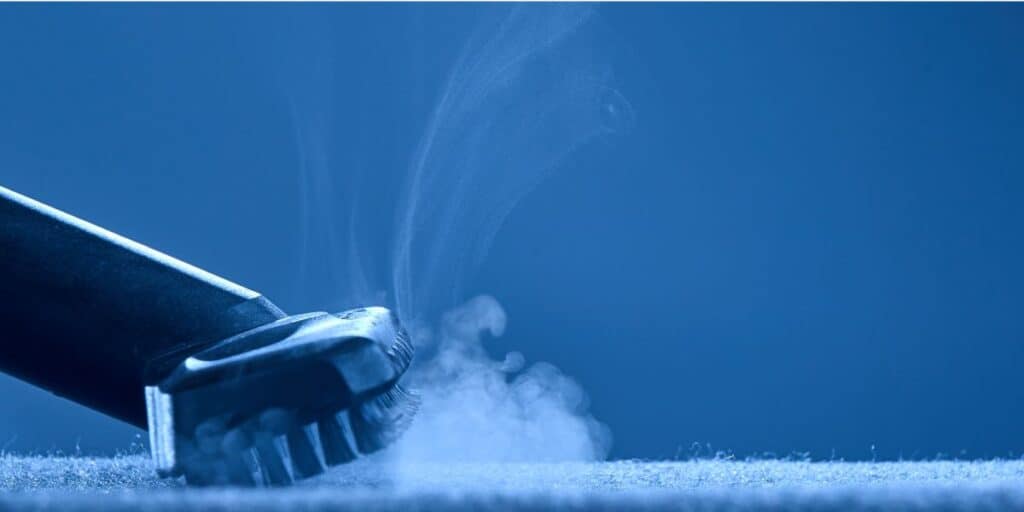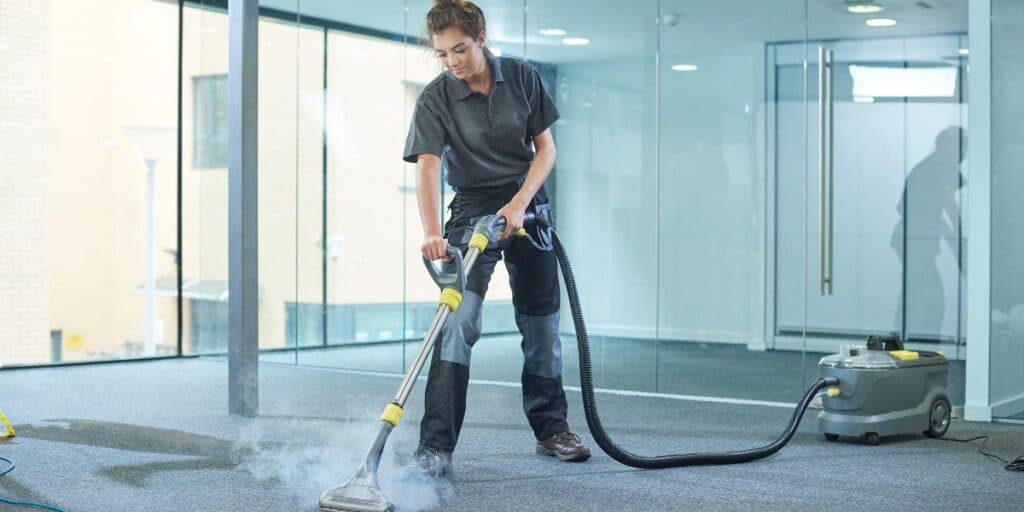If you’ve ever felt the cushiony embrace of a plush carpet beneath your feet, you’ll know the comfort and aesthetic appeal they bring to a room. Carpets, while beautiful, can be magnets for dirt, grime, and bacteria. Their intricate fibers, although soft and inviting, often harbor particles that elude regular cleaning. So how does one delve deep into the weft and warp, ensuring a clean carpet without damaging it?
Steaming is an effective way to clean carpets. It uses heated water to penetrate deep into the carpet fibers, dislodging dirt, bacteria, and allergens, thereby leaving your carpet fresh and sanitized.
As we venture further into this article, we will discuss the carpet steaming process and its effectiveness compared to traditional cleaning methods. We’ll touch upon its impact on different carpet materials, and address the debate between professional services and DIY approaches. Moreover, we’ll explore the long-term benefits of carpet steaming, and provide safety tips to ensure an efficient and hazard-free cleaning experience.
So whether you’re a carpet owner or a cleaning enthusiast, there’s a wealth of information waiting for you in the subsequent sections.
Understanding the Process of Carpet Steaming
What is Carpet Steaming?
Carpet steaming, despite its name, doesn’t actually involve steam. It’s a misnomer that sometimes leads to confusion. In reality, the process employs hot water extraction to clean your carpet thoroughly.
The method kicks off with a preconditioning agent, usually alkaline, applied to the carpet to break down soil particles. A specialized sprayer often disperses this agent, ensuring even distribution.

The Process Involved in Carpet Steaming
After preconditioning, the carpet steaming process begins in earnest. A high-pressure jet spray injects heated water into your carpet. These hot droplets of water penetrate deep into the carpet fibers, dislodging grime and bacteria.
This is where the magic happens. The high temperature of the water not only helps to break up dirt but also kills many types of bacteria and allergens lurking in the carpet. The simultaneous vacuuming action removes the loosened particles, extracting them along with the water. This leaves your carpet not only visibly clean but hygienically clean as well.
To finalize the process, carpets usually undergo a pH-balancing rinse. This step neutralizes any remaining cleaning solution, leaving your carpet fresh and squeaky clean. Carpets may also be groomed for appearance and then dried to complete the process.
Effectiveness of Carpet Steaming
How Carpet Steaming Removes Dirt and Bacteria?
There’s an elegant science to carpet steaming. Picture the heated water as it permeates the carpet fibers, easing out stubborn dirt and dust. The high temperature facilitates this process, disintegrating the grime and enabling its extraction. It’s a detailed cleanse, reaching parts of the carpet a regular vacuum couldn’t dream of accessing.
But it’s not just about dirt. Carpet steaming shows no mercy to bacteria and allergens either. The intense heat disrupts their structure, effectively neutralizing them. Herein lies a dual benefit – not only does your carpet look better, but the air you breathe becomes purer, free from potential allergens.
The Role of Heat and Steam in Carpet Cleaning
Heat, as we know, plays a starring role in carpet steaming. But why?
To answer this, we must delve into the properties of heat. It enhances the reaction rate between the cleaning solution and the soil, making the removal process more effective. Plus, the high temperature is lethal for most bacteria and allergens, ensuring a hygienic cleaning result.
Despite the term “steaming”, actual steam doesn’t have a significant role in this process. Remember, it’s essentially hot water extraction. Nevertheless, the moniker persists, painting a mental image of a deep, intense clean. And in practice, this is what carpet steaming delivers.
Deep Clean: Steaming vs. Traditional Cleaning Methods
Comparing Carpet Steaming with Dry Cleaning
Dry cleaning, another popular carpet cleaning method, uses a minimal amount of water and special detergents to clean your carpet. It’s quick, it’s convenient, and there’s little drying time involved. So how does it stack up against carpet steaming?
Let’s dive into the science. Dry cleaning can effectively remove surface dirt and stains, offering a quick refresh. However, the reduced water usage means it can’t reach as deep into the carpet fibers as steaming does. The lack of high heat also means it’s less effective against bacteria and allergens.
While dry cleaning has its merits, carpet steaming stands out for its depth of clean. A true deep-cleanse champion.
Comparing Carpet Steaming with Shampooing
Then we have shampooing. Picture a soapy lather working its way through your carpet, breaking down dirt. It sounds thorough, doesn’t it? But let’s not jump to conclusions.
Shampooing does offer a deeper clean than dry cleaning, reaching further into the carpet fibers. However, it often leaves a residue, which can attract more dirt over time. It also lacks the high temperatures of steaming, and thus, its sanitizing capabilities.
When weighed against steaming, the residue issue and the lower effectiveness against bacteria make shampooing a less favorable option for many.
In this exploration of cleaning methods, carpet steaming emerges as a powerful contender. It promises a clean that goes beyond the surface, eliminating hidden dirt and bacteria. But what about different types of carpets? That’s a topic for our next section. Stay tuned.
The Impact of Carpet Steaming on Different Types of Carpets
Considering Carpet Material: Wool, Synthetic, and Blends
Whether your carpet whispers luxury with its 100% wool or champions practicality with synthetic fibers, each type responds differently to cleaning methods. Let’s delve into this diverse world.
Wool, the epitome of opulence, is delicate. It requires careful handling. Steaming can clean wool carpets efficiently, but caution is needed. Excessive heat or pH imbalance could cause shrinkage or color fading. Hence, the right balance of temperature and a pH-neutral cleaning solution are critical.
Synthetic carpets, on the other hand, are more forgiving. Nylon, polyester, or olefin, they withstand higher temperatures, making them ideal candidates for steaming. They resist shrinkage and color fading, allowing for a deep, thorough clean.
Blended carpets combine the best of both worlds. The challenge here lies in maintaining the integrity of each type of fiber during the cleaning process. Expertise and understanding are key.
Addressing Common Concerns: Color Fastness and Shrinkage
Color fastness and shrinkage, two common concerns associated with carpet steaming, need addressing. With professional services or careful DIY, these risks can be minimized.
The key to preventing color fading lies in maintaining an appropriate heat level and using a pH-neutral cleaning solution. As for shrinkage, it’s often caused by over-wetting and insufficient drying. An expert cleaner knows how to control these factors, ensuring your carpet retains its original charm.
We’ve navigated the nuances of carpet materials and addressed common concerns related to steaming. This method, when executed correctly, can deliver impressive results on a wide array of carpets. But who should be in charge of this process – professionals or the homeowners themselves? We’ll explore this in our next section.
Professional Steaming vs. DIY: Making the Right Choice
The Pros and Cons of Professional Carpet Steaming Services
When you hire professionals, you’re paying for experience, expertise, and high-grade equipment. They understand carpet fibers, they know the optimal temperature settings, and they balance cleaning solutions just right. In short, they’re equipped to tackle every carpet steaming challenge.
But this expertise comes at a price. Professional services can be costly. Moreover, you’ll have to schedule your cleaning to align with their availability. Sometimes, these constraints make homeowners consider the DIY route.

The Pros and Cons of DIY Carpet Steaming
DIY carpet steaming can seem alluring. The freedom to clean your carpet when it suits you, the satisfaction of doing it yourself, and the potential cost savings are tempting.
However, this path is not without its pitfalls. You’d need to rent or buy a carpet steamer, understand its operation, and get familiar with the cleaning process. Over-wetting, under-drying, using incorrect cleaning solutions – the risks of DIY are plenty. In worst-case scenarios, you might end up damaging your carpet.
Thus, choosing between professional services and DIY involves weighing convenience, cost, and confidence in your ability to execute the task. As we’ve discovered in this section, both options have their merits and drawbacks. Ultimately, the choice depends on your individual needs and circumstances.
Next up, we’ll delve into the long-term benefits of carpet steaming. How does this deep cleaning method impact your carpet’s lifespan and your indoor air quality? Let’s find out.
The Long-Term Benefits of Carpet Steaming
Extending Your Carpet’s Lifespan
Imagine a carpet, its fibers entwined with particles of dust, dirt, and grime. Over time, these particles can act like sandpaper, damaging the fibers with every step you take. The result? A carpet that wears out before its time.
Now, picture a steamed carpet. The hot water extraction process removes these damaging particles, preventing fiber erosion. The result is a carpet that not only looks cleaner but also lasts longer. Long-term, consistent carpet steaming can significantly extend your carpet’s lifespan, making it a worthwhile investment.
Enhancing Indoor Air Quality
Beyond visible cleanliness, there’s another arena where carpet steaming shines – indoor air quality.
Carpets, much like filters, trap allergens, dust mites, and bacteria. When left unchecked, these contaminants can become airborne every time you walk on the carpet. The result? Potential allergens polluting your indoor air.
Carpet steaming tackles this issue head-on. The high-temperature water extraction process effectively removes these contaminants, reducing the chance of them becoming airborne. Thus, regularly steamed carpets contribute to a healthier indoor environment, making your home not just cleaner, but also healthier.
Through this exploration, we’ve seen how carpet steaming extends beyond surface cleanliness. Its impacts are deep and far-reaching, contributing to the longevity of your carpet and the quality of your indoor air.
But how can you ensure a safe and effective carpet steaming process? Stay with us as we delve into some crucial safety precautions and expert tips in our next section.
Safety Precautions and Tips for Effective Carpet Steaming
Prepping for Safety
Carpet steaming, like any cleaning process involving heat and water, requires careful handling. One must approach it with an eye for safety.
Electricity and water make for a hazardous combination. Ensure your machine’s cord, plug, and outlet are in good condition. Keep all connections dry. These simple precautions can prevent potential electrical mishaps.
Children and pets often have an uncanny knack for showing up where they shouldn’t. Keep them away from the area being cleaned until the carpet is completely dry. This helps prevent accidental slips or exposure to cleaning solutions.
Maximizing Effectiveness Through Proper Technique
Now that we’ve covered safety, let’s focus on maximizing the effectiveness of carpet steaming. It starts with preconditioning. Apply the cleaning solution and allow it to sit for a while. This gives it time to break down the dirt and grime.
Next, it’s all about the steam. Remember, slower is better. A rushed job won’t allow the water to penetrate deep into the fibers and do its magic. Take your time, let the steam penetrate, and then extract slowly. Patience, as they say, is the key.
Drying is the final step, but by no means the least important. It’s vital to prevent mold and mildew. Use fans, dehumidifiers, or just open the windows for natural ventilation.
Through the interplay of safety precautions and efficient techniques, carpet steaming can yield impressive results. A deeper clean, extended carpet life, and improved indoor air quality – all within reach when you harness the power of steam.
In our final section, we’ll recap what we’ve learned and provide a conclusion to our deep-dive into carpet steaming. Join us for the wrap-up.
Wrapping Up: The Power and Promise of Carpet Steaming
Recapitulating Our Carpet Steaming Journey
We embarked on this exploration to answer a question: Does steaming clean your carpet? We’ve dived deep into the process, scrutinizing its effectiveness, comparing it with other cleaning methods, examining its impact on different types of carpets, and discussing the choice between professional services and DIY.
Through this journey, we’ve discovered that carpet steaming is a potent cleaning method. It has the power to dislodge and remove dirt, grime, bacteria, and allergens, reaching places traditional cleaning methods can’t.
Embracing the Benefits of Carpet Steaming
Beyond immediate cleanliness, carpet steaming promises long-term benefits. It extends your carpet’s lifespan, protects its fibers, and contributes to healthier indoor air. It’s an investment not just in the appearance of your carpet, but in its longevity and your home’s overall health.
However, as with any method, it requires careful execution. From selecting the right temperature and cleaning solution to ensuring proper drying, every step matters. Whether you choose to hire professionals or take the DIY route, an informed approach is essential.

Concluding Thoughts: Carpet Steaming as a Comprehensive Cleaning Solution
To wrap up, carpet steaming does more than just clean your carpet. It revitalizes it, restores it, and contributes to a healthier indoor environment. It’s a cleaning method that marries the power of heat with the simplicity of water, delivering results that go beyond the surface.
In a world where cleanliness has become paramount, carpet steaming stands out as a comprehensive cleaning solution. It’s the deep clean your carpet deserves, the long-lasting freshness your home needs.
In concluding, we leave you with this thought: Give your carpet the deep clean it deserves, experience the difference steaming can make. Who knows? You might just fall in love with your carpet all over again.
Article Sources:
